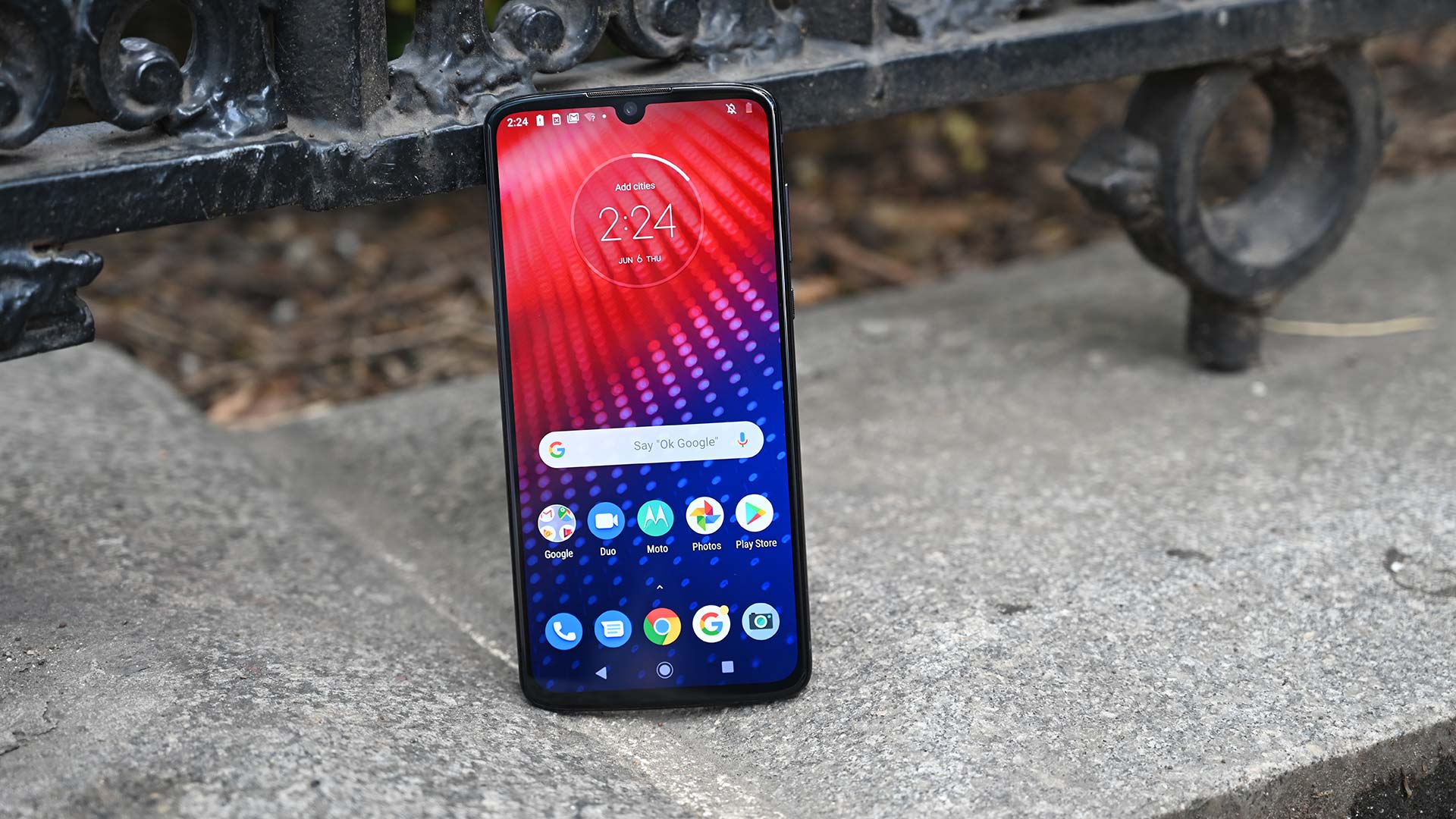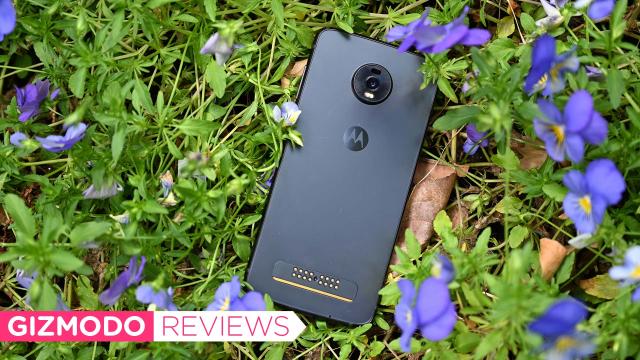While Samsung, Apple, Huawei, and others continue to push out $1,500+ phones, Motorola has run in the other direction and completely abandoned the flagship market. That’s a pretty serious about-face from just two years ago when Motorola released the $US750 ($1,070) Moto Z2 Force, especially when you consider that the most expensive phone Motorola makes now is the $US500 ($713) Moto Z4.

Moto Z4
What is it?
A mid-range phone with modularity
Price
$US500 ($713)
Like
Big OLED display, solid battery life and performance, clean build of Android 9, Moto brought back the headphone jack
Don't Like
In-screen fingerprint sensor can be hit or miss, you really need to take advantage of mods to get the phone’s true value, Night Vision pics can look a bit blurry
Editor’s Note: We don’t have any local pricing or release info for the Moto Z4 as yet.
However, even with Motorola’s more modest ambitions, the company still hopes to deliver on a mid-range device with more premium aspirations. Compared to our current favourite budget phone—the $500 Moto G7—the Moto Z4 offers some significant upgrades including a 6.39-inch OLED screen, some high-megapixel cameras in front and back, the biggest battery Motorola has ever put in a Z-series phone, and of course, the return of the all-important headphone jack. Hell, the Z4 even has an in-display fingerprint reader which up til now, was a feature found almost exclusively on high-end handsets
All told the Z4 ticks a lot of boxes and avoids any major flaws (aside from one potentially frustrating feature), and yet even though I kind of like the phone, I’m having a hard time feeling much more than that. But let’s start with the good stuff.
For a $US500 ($713) phone, the Moto Z4’s OLED screen looks great. Colours appear rich, and with a peak brightness just shy of 600 nits (589 nits to be exact), the Z4’s luminance is on the same level as many flagship devices. And while the Z4 does have a notch, it’s about as unobtrusive as a notch can be, and considering any current solution that would allow for an all-screen display would easily push the Z4’s price north of $US500 ($713), I’m not bothered. And because the Z4’s bezels are slimmer than what you get on Pixel 3a or 3a XL, you get more usable screen area, because while the phones are approximately the same size, the Pixel 3a XL’s screen tops out at 6-inches.
Inside, the Z4 comes with a Qualcomm Snapdragon 675 processor, 4GB of RAM and 128GB of storage. That last part is a big deal because it’s double what you get from a Pixel 3a, and that’s before you tack any additional storage via the phone’s microSD card slot—a feature the Pixel 3 doesn’t have.
Despite its Snapdragon 675 chip being a couple steps down from the Snapdragon 855 processor you find in a lot of high-end phones, the Z4 still feels quite snappy, particularly if most of your time is spent browsing the web or checking social media. On WebXPRT 2015, which evaluates web browsing performance, the Z4’s score of 258 was just 10 per cent lower than the LG G8’s score of 284 (though the Galaxy S10’s score was much higher at 361). The only time the Z4’s performance was ever really an issue was when playing more demanding games like PUBG Mobile or Auto Chess, where you tend to run into a big of lag depending on game settings.
Motorola even managed to cram stereo speakers on the Z4, and while audio quality is just OK, it beats the mono speakers you often find on phones in this price range. And then there’s the Z4’s headphone jack, which has finally returned after nearly four years when Motorola axed the jack on the original Moto Z. The simple fact that Motorola finally relented under the pressure of consumer complaints is kind of shocking, and in a world where companies rarely bring back features after killing them off the first time, some might even say it’s courageous. Either way, it’s a welcome return.
I also have to give a special shout out to Motorola for giving the Z4 a 3,600 mAh battery (the biggest battery ever in a Moto Z phone), as it let the Z4 last 13 hours and 49 minutes on our battery test. That’s an hour longer than the Pixel 3a XL (12:43) and two hours longer than the regular Pixel 3a (11:51), though the OnePlus 6T still tops them all with a time of 14:37.
As for the Z4’s cameras, Motorola gave the phone high-resolution shooters on both sides with a 25-MP selfie cam up front, and a 48-MP camera in the back. Both cameras use a technique called pixel binning, which combines four adjacent into one big pixel to deliver better low light sensitivity. Strangely, while there is a setting you can adjust to get the selfie cam’s full 25-MP instead of the effective 6-MP pics it takes by default, there doesn’t seem to be an option to shoot full 48-MP shots with the rear cam.
In normal conditions, the Z4 has very little difficulty snapping Insta-worthy pics with bright colours and sharp focus, though when compared to pics from a Pixel 3a, you’ll notice that the Pixel has an edge in detail. A good example of this difference is the extra level of detail you can see on the bricks on the New York Public Library in the Pixel 3a’s shot below. And in another shot of a nearby street mural, the Z4’s shot appears overexposed and lacks the same level of detail, contrast, and dynamic range as what I got from the Pixel 3a.
When nighttime rolls around, Motorola also gave the Moto Z4 Night Vision mode, because nowadays, every phone basically needs to have a special low-light shooting mode. Unfortunately, while the Z4’s Night Vision does a decent job of turning up the brightness when it’s dark, using Night Vision also tends to result in a loss of sharpness, something you can see in both the shot of an outdoor restaurant taken at night, and the shot of a croquette taken indoors with the lights turned down. I like that Moto stepped up to give customers more tools to deal with challenging low-light shots, but considering the Pixel 3a basically has the same camera as its more expensive sibling, it’s tough to beat what remains the best smartphone camera in this price range.
Finally, we come to the Z4’s frustrating features. Even as a fan of in-display fingerprint sensors, the one you get on the Z4 can be a bit of a headache. Out of all the phones I’ve tried with similar tech, the optical fingerprint reader buried underneath the Z4’s screen is the least reliable. Sometimes it works perfectly fine, while other times it takes three or four taps to unlock the thing, with fingerprint recognition appearing to struggle slightly more when used outside in super bright environments.
And there’s the Z4’s modularity. Even after Motorola’s three-year commitment, the Z4 still has a strip of pogo pins on its back that lets you connect one of Motorola’s 16 or so attachments. With the Z4’s retail price $US100 ($143) more than a Pixel 3a, it sort of feels like you need to at least have one mod in mind to extract the Z4’s full value. But out of Motorola entire list of mods, there’s only two or three that I like: the Moto GamePad, the JBL SoundBoost 2, and maybe the Polaroid Insta-Share Printer (assuming shareable retro photos are your kind of thing). That’s about it.
At $US200 ($285), the Moto Insta-Share Printer and Hasselblad camera mod are too expensive to love, and even back when it was released, the Hasselblad mod’s pictures always looked a bit soft. You’re much better off sticking with the Z4’s primary camera unless you want that extra zoom. And while at one point there was a wireless charging shell for Motorola’s Z phones, that seems to have gone out of production.
The one possible exception is the Moto 5G mod. But not because of what it can do now, but potentially what it could do in the future. Based on the current state of 5G deployment, there’s very little reason for 99.9 per cent of people to buy a 5G phone in 2019. But in a year or two when 5G coverage becomes much more widespread, the ability to add 5G capability to the Z4 for $US200 ($285) could save you the expense of having to buy a whole new phone.
But that’s a big “could” because right now, the 5G Moto mod only works on Verizon, and there’s no word if or when other carriers might put out their own 5G mod. On top of that, only Moto Z4s purchased through Verizon will have support for the 5G mod at launch. Motorola is planning on adding that capability to unlocked Z4s in the future, but haven’t said when that will happen yet.
But the most challenging thing the Z4 has to contend with are the other phones on either end of its price bracket. Even without competition from affordable Chinese handsets like the Xiaomi Mi 9, Nubia Red Magic 3 and others, for my money, I still prefer the $649 Pixel 3a or OnePlus 6T over the Moto Z4. The Pixel 3a costs less, has a better camera, and true stock Android 9 instead of Moto’s near stock implementation, while the OnePlus 6T looks better, lasts longer, and has way better performance.
I like the Moto Z4, and if one of its mods catches your eye, you might too. But at this point, I wonder if after four years of support for its mod platform, maybe it’s time for a reboot or a new approach to add some extra excitement to Moto’s Z-series phones.
README
-
Moto gave the Z4 a new Night Vision to help with low-light photos. Unfortunately, it’s not quite as good as Night Sight on the Pixel 3a.
-
While it retails for $US500 ($713), the Z4 does come with some premium features like a vibrant OLED screen, stereo speakers, and an in-display fingerprint reader, though the latter can be somewhat finicky.
-
After four years and some user complaints, Motorola finally brought back the headphone on the Z4.
-
At launch, the 5G Moto Mod is only compatible with Moto Z4s purchased through Verizon. Unlocked models are slated to get support at a later date.
-
The Z4 is somewhat water resistant thanks to Moto’s nano-coating, but it’s not meant to withstand more than a light splash.
